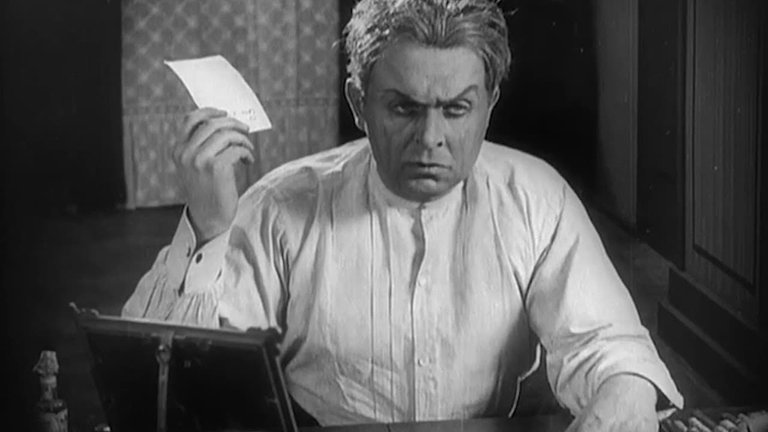Film Review: Dr. Mabuse, the Gambler (Dr. Mabuse, der Spieler, 1922)

20th Century produced many iconic archvillains, both in real life and in fiction. Among the latter one of the most famous, partly because it allegedly inspired the former, is criminal mastermind Dr. Mabuse. He first appeared in Dr. Mabuse, the Gambler, 1921 serialised crime novel by Luxembourgian writer Norbert Jacques. A year later the novel was in Germany adapted into eponymous silent film directed by Fritz Lang, which is nowadays considered one of the classics of Weimar cinema and also known as the start of film series that would last for decades.
The title character, played by Rudolf Klein-Rogge, is Dr. Mabuse, psychoanalyst who also possesses hypnotic abilities, as well as talent for impersonation, which he abuses in order to, together with small band of confederates, create little criminal empire. His modus operandi includes taking various identities, and one of those is a famous stock broker who will make a killing at stock market through carefully staged robbery of a courier carrying important business documents. His next target is Edgar Hull (played by Paul Richter), son of rich industrialist who, with the help of beautiful dancer Cara Carozza (played by Aud Egede-Nissen) gets cheated of small fortune in illegal casino. One person that suspects that all those incidents might be work of single individual is State Prosecutor Norbert von Wenk (played by Bernhard Goetzke) who begins his own investigation, sometimes applying impersonation himself. In order to catch Dr. Mabuse he will receive help of beautiful Countess Dusy Told (played by Gertrude Welker), whose mentally unbalanced husband Count Told (played by Alfred Abel) is one of the victims of Mabuse’s manipulations.
Producer Erich Pommer obtained the rights and work on film began while Jacques’ novel wasn’t serialised till the end. This might explain why scriptwriter Thea von Harbou and director Fritz Lang felt more constrained with literary source and its serial nature, resulting in film that at times looks like early silent cinema serials, including those by French director Louis Feuillade that had obviously served as inspiration for Lang. Ultimately, Dr. Mabuse is extremely long film that last nearly four and half hours in integral version and was originally distributed in two parts. As such, it requires much more patience from viewers, even those accustomed to technical limitations of silent cinema. It takes some time before Dr. Mabuse starts going, but one it does, von Harbou’s script makes good sense and viewers will be rewarded with interesting characters, plot and its action-packed resolution. Long running time also allows Lang to turn his film into some sort of commentary on state of Germany in early 1920s, including economic chaos that reflects in stock market shenanigans and currency manipulations, as well as political troubles reflected in Mabuse taking identity of street agitator who stirs impoverished mob to do his bidding. Lang even takes luxury on commenting on German Expressionism which is explicitly mentioned in characters’ dialogue. Lang’s realistic approach is also reflected in scenes featuring nudity and character using rather salty language for 1920 standards.
Dr. Mabuse benefits a lot from inspired cast. Rudolf Klein-Rogge, who was during production married to Thea von Harbou, delivers strong performance in complex role that requires his character to take multiple identities. During the shooting von Harbou began affair with Lang, who would eventually marry. All that, however, didn’t reflect on the film. Klein-Rogge’s separation with his wife was done amicably and actor later didn’t have any problems working with Lang again, resulting in his most iconic role of mad scientist Rotwang in Metropolis five years later. Lang also shows how he was willing to use technical innovations, like in scenes of hallucinations that feature more decent special effects for its time, as well as nighttime cinematography, something quite rare for cinema of its time.
Dr. Mabuse was rather successful at the box and one of its fans was allegedly an upstart politician named Adolf Hitler. Some critics were prone to interpret Dr. Mabuse as embodiment of anti-Semitic stereotypes, but, later, many saw Dr. Mabuse as inspiration for future German leader and his hypnotic speeches that helped him seduce masses and pave his way to power. In 1933, shortly before Hitler’s coming to power, Lang made sound sequel The Testament of Dr. Mabuse and in 1960 West Germany he made another sequel under title The Thousand Eyes of Dr. Mabuse, which would later spawn series of four more films produced by Artur Brauner.
RATING: 6/10 (++)
_
Blog in Croatian https://draxblog.com
Blog in English https://draxreview.wordpress.com/
InLeo blog https://inleo.io/@drax.leo
InLeo: https://inleo.io/signup?referral=drax.leo
Unstoppable Domains: https://unstoppabledomains.com/?ref=3fc23fc42c1b417
Hiveonboard: https://hiveonboard.com?ref=drax y
Bitcoin Lightning HIVE donations: https://v4v.app/v1/lnurlp/qrcode/drax
Rising Star game: https://www.risingstargame.com?referrer=drax
1Inch: https://1inch.exchange/#/r/0x83823d8CCB74F828148258BB4457642124b1328e
BTC donations: 1EWxiMiP6iiG9rger3NuUSd6HByaxQWafG
ETH donations: 0xB305F144323b99e6f8b1d66f5D7DE78B498C32A7
Posted using CineTV
👍 ❤️ Upvoted ❤️ 👍